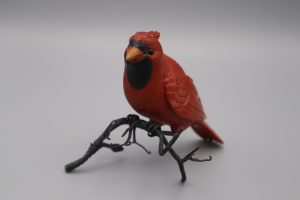Special Exhibit
Inspiration Fabergé: Gemstone Carving
March 10 to June 18, 2023
Features carvings of animals, figures, and flowers carved in Germany and Russia.
The exhibit reflects the style of Fabergé design that goes back to the late nineteenth century
and gem cutting traditions that continue today.

Regular Museum Admission – Regular Museum Hours
Inspiration Fabergé – Gemstone Carvings

The Museum’s new special exhibit features carvings of animals, figures, and flowers carved in Germany and Russia. The German carvings have been in the collection for decades. In fact, all the Museum’s dioramas feature animals carved in Idar-Oberstein. The exhibit reflects the style of Fabergé design that goes back to the late nineteenth century and gem cutting traditions that continue today.
In the early 1960s the Museum’s founder visited Idar-Oberstein, Germany and found a dynasty of family workshops – artisans working together – producing all kinds of gemstone items from faceted stones to jewelry, bowls to cameos, animals and figurines, even lamps and tables.
The German carving tradition goes back at least to the Middle Ages when agates and quartz were mined in the region. Scholars debate if Romans taught the Germans the art of gem engraving. In any case, the German inhabitants utilized the rushing water of the Nahe river to power their immense, locally mined, sandstone wheels to begin working with stone. They had the perfect location and ingenuity to become a world renown area for lapidary artists.

Workshops of generational knowledge in cutting and polishing came from a system of apprenticeship offered to the sons in every family and included outsiders who wanted to learn. Beginning as a teenager, it took decades to become a master lapidary.
The Fabergé connection began in the late 1880s when Carl Fabergé’s gem broker recognized the lapidary talent in the twin towns of Idar-Oberstein. Fabergé soon supplied plaster models of animals he wanted produced. The best craftsmen were selected to reproduce the models in stone and by the early 20th century the German workshops were faithfully replicating Fabergé pieces especially flowers, animals, and figurines. After World War I, Russia nationalized the Fabergé firm. Records were destroyed further obscuring the link between Russia and Germany.

Idar-Oberstein craftsmen carried on with their knowledge and expertise of carving continuing to replicate Fabergé styles and, in some cases, aesthetically improving upon designs. The carvings from Idar-Oberstein today use high quality gemstones and often composites of gem materials to convey meticulous realism. Carving tools and polishing methods have evolved contributing to improvements in carving.
The Russian lapidary workshops show a remarkably similar resilience. After the upheavals of World War II, craftsmen and women continued the long tradition of working with stone. The Russian lapidaries have maintained a very high level of craftsmanship. The wealth of rough stone in, or accessible to, Russia is extensive including lapis lazuli, malachite, white Kascholong opal, rhodonite, and jade. Today Russian workshops carry on Fabergé traditions in carving. In this exhibit, Russian stones are featured in a mosaic and three folkloric figures styled after Fabergé’s assembled gemstone figurines. The special exhibit Inspiration Fabergé is currently on display through June 18, 2023.
References
Alexander von Solodkoff, (1988) The Art of Carl Fabergé, Crown Publishers, New York.
Gems & Gemology, (2017) Vol. 53, No.4 pp. 404-422, Gemological Institute of America.
Snowman A.K., (1962) The Art of Carl Fabergé, Faber & Faber, London.
V. Skurlov, T. Fabergé and V. Iluvin, (2009) K. Fabergé and His Followers – Faces of Russia, St. Petersburg, Russia.






